I am building a faceted plot where each panel has 3 different sets of points, each with a different shape. Everything works fine, until I try to add some text to each panel using geom_text(). When I include geom_text()in the plot, I get an error message that I have "insufficient values in a manual scale: 4 are needed but only 3 are provided". I can correct this problem by adding additional shapes and colors, but I cannot control the re-mapping of the shape/color factors that occurs when I add geom_text().
Here is the script that I am running:
library(ggplot2)
library(RColorBrewer)
library(cowplot)
make_hist_df <- function (vals, breaks, expt, type) {
hist_d <- hist(vals,breaks=breaks,plot=FALSE)
hist_d_nz<-hist_d$counts > 0
n_d_nz<-length(hist_d$counts[hist_d_nz])
hist_df <- data.frame(expt=character(n_d_nz), counts=numeric(n_d_nz), mids=numeric(n_d_nz),type=character(n_d_nz))
hist_df$counts <- hist_d$counts[hist_d_nz]
hist_df$mids <- hist_d$mids[hist_d_nz]
hist_df$expt = expt
hist_df$type = type
return(hist_df)
}
## get some normal distributions
n1<-rnorm(n=10000, mean=5,sd=1)
n2<-rnorm(n=5000,mean=15,sd=1)
n3<-rnorm(n=2000,mean=25,sd=1)
breaks=seq(0,30,0.5)
tot_hist_df = rbind(
make_hist_df(n1,breaks,expt='one',type='low'),
make_hist_df(n2,breaks,expt='one',type='mid'),
make_hist_df(n3,breaks,expt='one',type='high')
)
tot_hist_df = rbind(tot_hist_df,
make_hist_df(n1,breaks,expt='two',type='low'),
make_hist_df(n2,breaks,expt='two',type='mid'),
make_hist_df(n3,breaks,expt='two',type='high')
)
tot_hist_df$expt<-factor(tot_hist_df$expt,levels=c('one','two'), ordered=TRUE)
tot_hist_df$type<-factor(tot_hist_df$type,levels=c('low','mid','high'), ordered=TRUE)
s.open_circ<-1
s.closed_circ<-16
s.triangle <- 2
s.plus<-4
s.dot <- 20
sb.shapes = c(s.open_circ, s.triangle, s.closed_circ)
sb.shapes_l = c(s.open_circ, s.triangle, s.closed_circ, s.dot)
q_set <- c('N1','N2','N3')
n_q <- length(q_set)
sb.colors <-brewer.pal(max(3,n_q),'Dark2') # 'Dark2', 'Set2', 'Paired'
sb.colors_l <- c(sb.colors,'black')
sb.sizes = rep(1.25,n_q)
## plot out without labels
p1 <- ggplot(data=tot_hist_df,aes(x=mids, y=counts, shape=type, color=type))+geom_point() +
scale_color_manual(values=sb.colors) +
scale_shape_manual(values=sb.shapes) +
facet_wrap(~expt, ncol=2)
## make a label dataframe
hist_label=data.frame(expt=c('one','two'), lab=c('mean 5, 20','mean 5, 20 - dup'),type=c('xlab','xlab'))
hist_label$expt <- factor(hist_label$expt,levels=c('one','two'),ordered=TRUE)
hist_label$type <- factor(hist_label$type,levels=c('low','mid','high','xlab'),ordered=TRUE)
## plot out without labels
p2 <- ggplot(data=tot_hist_df,aes(x=mids, y=counts, shape=type, color=type))+geom_point() +
geom_text(data=hist_label, aes(x=10,y=1000,label=lab)) +
scale_color_manual(values=sb.colors_l) +
scale_shape_manual(values=sb.shapes_l) +
facet_wrap(~expt, ncol=2)
plot_grid(p1,p2,ncol=1)
And here is the output that it produces: bad plot
Both the colors and shapes differ between the top and bottom panel.
I do not understand why geom_text() is remapping the factor levels specified by "type", after I have explicitly specified them for both the plotted data and for the label data structure. This remapping (to something that looks alphabetical) throws off both the colors and the shapes.


